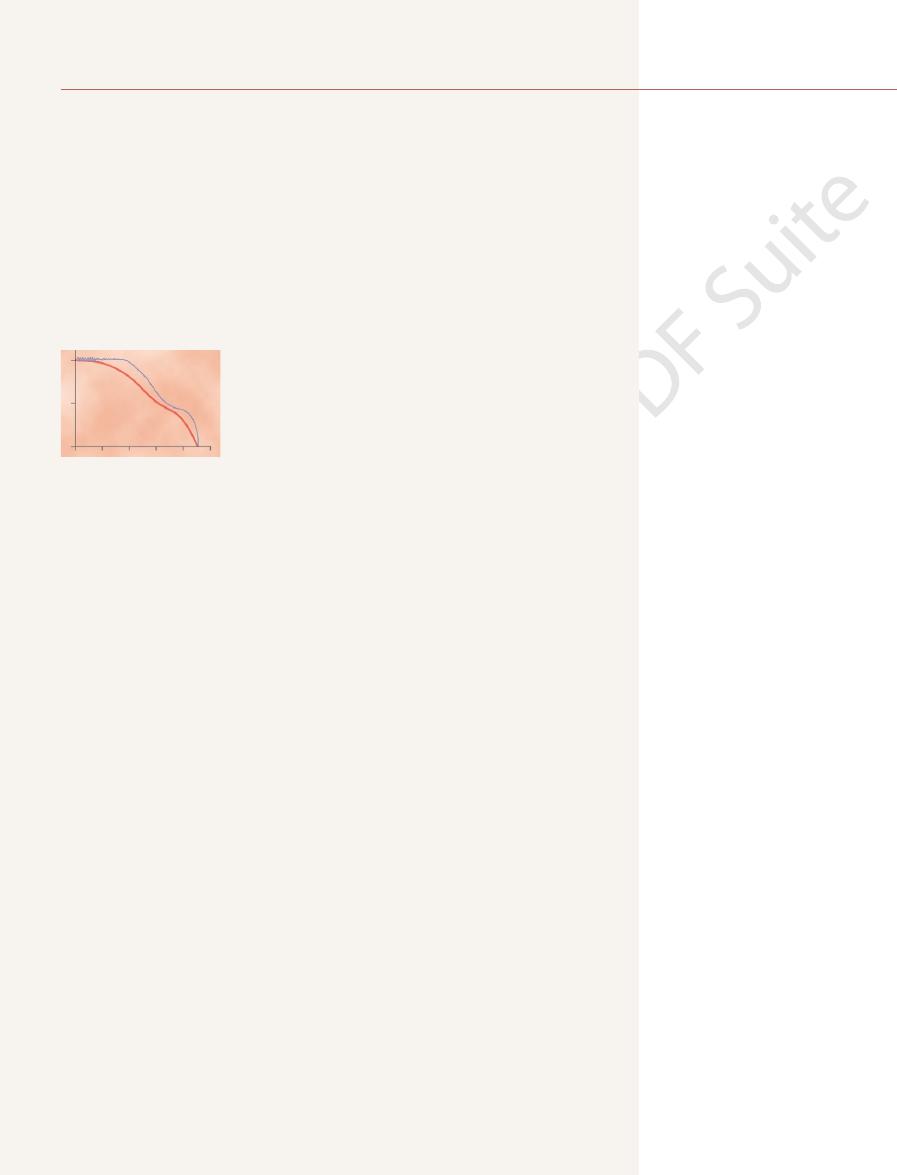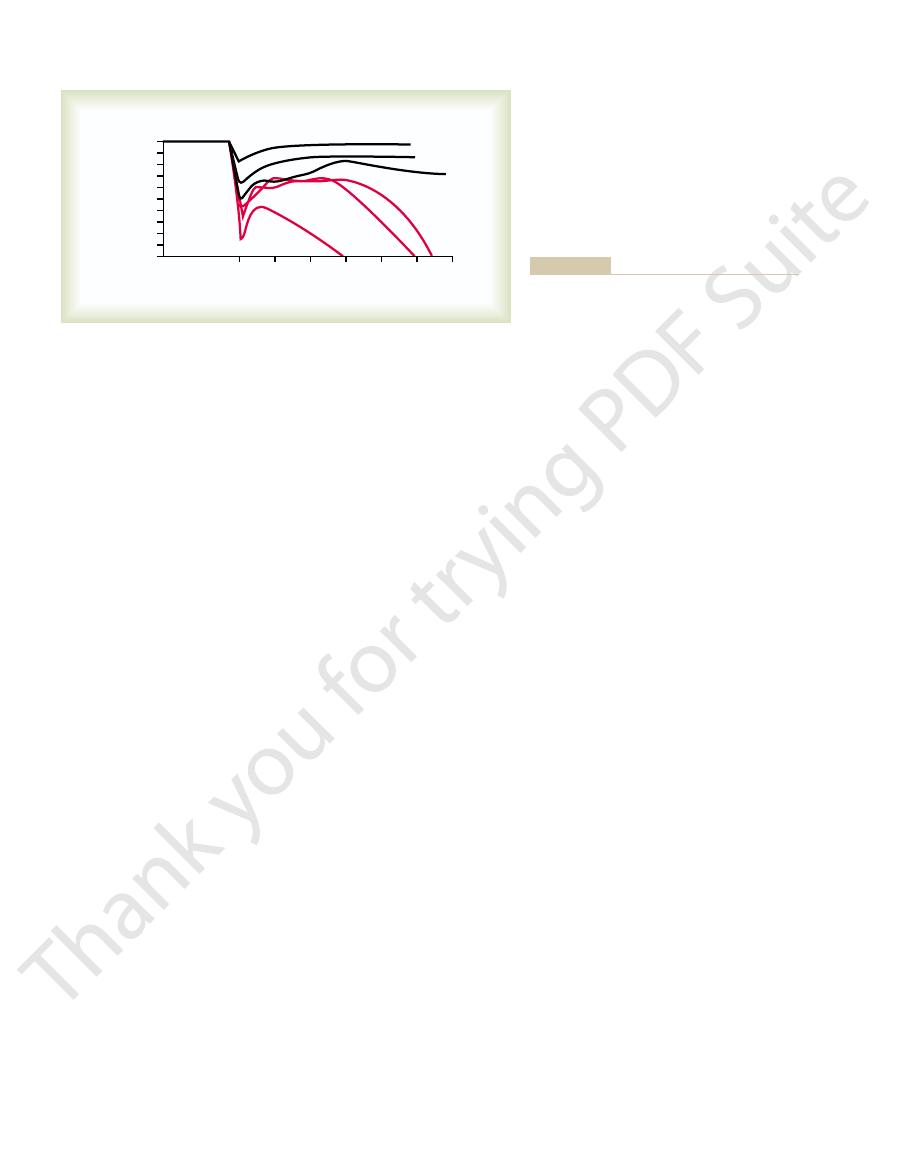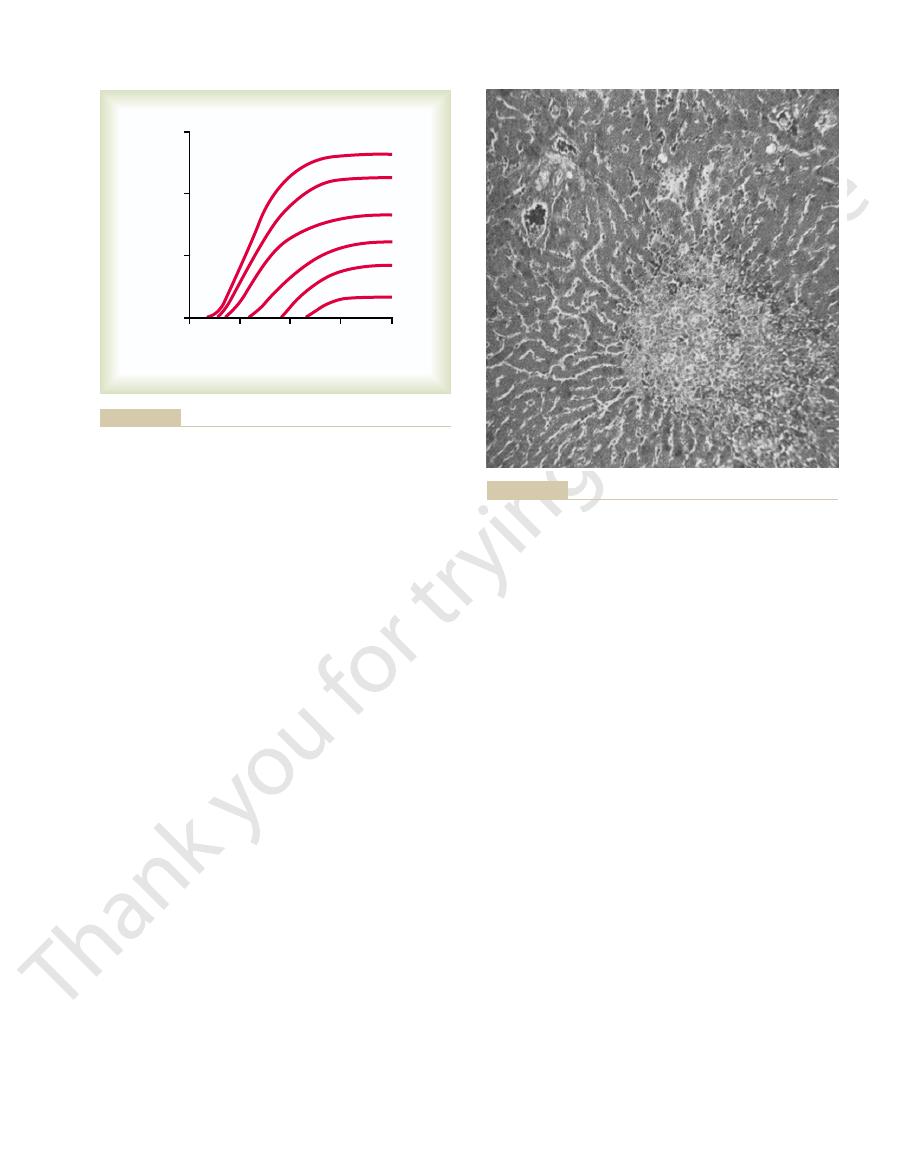
lar waste products from the tissues.
to critical tissues and critical organs and also cause inadequate removal of cellu-
The specific causes of shock are discussed later in the chapter. For the present,
tissue perfusion patterns, so that most of the cardiac output is passing through
the body, so that even a normal cardiac output is inadequate,
person is in circulatory shock. This can result from (1)
Occasionally, the cardiac output is normal or even greater than normal, yet the
Circulatory Shock That Occurs Without Diminished
in the circulation, especially in the venous return pathway to the heart.
obstruction to blood flow
of the venous blood reservoirs, or
decreased vascular tone,
diminished blood volume,
the heart cannot pump blood that does not flow into it. The most common
Factors that decrease venous return
who develop cardiogenic shock do not survive.
Chapter 22, where it is pointed out that as many as 85 per cent of people
This is discussed in detail in
cardiogenic shock.
conditions. The circulatory shock that results from diminished cardiac
arrhythmias,
toxic states
myocardial infarction
These include especially
Cardiac abnormalities that decrease the ability of the heart to pump blood.
shock. Two types of factors can severely reduce cardiac output:
Shock usually results from inadequate cardiac output. Therefore, any condition
that the shock, once begun, is prone to become progressively worse.
other circulatory parts—begins to deteriorate, so
walls of the blood vessels, vasomotor system, and
diovascular system itself—the heart musculature,
nutrients delivered to the tissue cells. Even the car-
body tissues are damaged because of too little flow,
blood flow through the body, to the extent that the
Circulatory shock
Physiology of Its Treatment
C
H
A
P
T
E
R
2
4
278
Circulatory Shock and
means generalized inadequate
especially because of too little oxygen and other
Physiologic Causes of Shock
Circulatory Shock Caused by Decreased Cardiac Output
that reduces the cardiac output far below normal will likely lead to circulatory
1.
but also
of
the heart, severe heart valve dysfunction, heart
and other
pumping ability is called
2.
also decrease cardiac output because
cause of decreased venous return is
but venous
return can also be reduced as a result of
especially
at some point
Cardiac Output
excessive metabolism of
or (2) abnormal
blood vessels besides those that supply the local tissues with nutrition.
it is important to note that all of them lead to inadequate delivery of nutrients

venous reservoirs constrict, thereby helping to main-
the total peripheral resistance. (2) The veins and
parts of the systemic circulation, thereby increasing
important effects: (1) The arterioles constrict in most
tor system throughout the body, resulting in three
These reflexes stimulate the sympathetic vasoconstric-
vascular stretch receptors, as explained in Chapter 18).
The decrease in arte-
Value to Maintain Arterial Pressure.
Sympathetic Reflex Compensations in Shock—Their Special
arterial pressure, both of which fall to zero when about
rial pressure or cardiac output, but greater blood loss
minutes. About 10 per cent of the total blood volume
Figure 24–1 shows the approximate effects on both
Cardiac Output and Arterial Pressure
Relationship of Bleeding Volume to
normal, and shock may ensue.
return. As a result, the cardiac output falls below
and, as a consequence, decreases venous
shock. Hemorrhage
means diminished blood volume. Hem-
Hypovolemia
teristics of shock initiated by other causes.
basic principles. Then we can consider special charac-
caused by decreased blood volume, which illustrate the
Now, let us discuss the stages of circulatory shock
person is still alive.
person’s life, even though, for the moment, the
irreversible stage,
3. An
in which, without therapy,
progressive stage,
2. A
therapy.
), in which the normal
1. A
change with different degrees of severity, shock is
shock, and so forth until death. It is with this late stage
culatory shock, less adequate tissue perfusion, more
vicious circle ensues, with progressively increasing cir-
an even greater decrease in cardiac output, and a
ing the heart and circulatory system itself. This causes
causes the body tissues to begin deteriorating, includ-
That is, the inadequate blood flow
breeds more shock.
the shock itself
ity, regardless of its initiating cause,
Tissue Deterioration Is the End Result
at the same time as the cardiac output decreases,
severe blood loss, the arterial blood pressure decreases
In most types of shock, especially shock caused by
arterial pressure can fall to half of normal, but the
keep the pressure from falling. At other times, the
be seriously misleading. At times, a person may be in
tory function. However, the arterial pressure can often
level is the principal measure of adequacy of circula-
In the minds of many physicians, the arterial pressure
What Happens to the Arterial Pressure
Circulatory Shock and Physiology of Its Treatment
Chapter 24
279
in Circulatory Shock?
severe shock and still have an almost normal arterial
pressure because of powerful nervous reflexes that
person still has normal tissue perfusion and is not in
shock.
although usually not as much.
of Circulatory Shock, Whatever
the Cause
Once circulatory shock reaches a critical state of sever-
of circulatory shock that we are especially concerned,
because appropriate physiologic treatment can often
reverse the rapid slide to death.
Stages of Shock
Because the characteristics of circulatory shock
divided into the following three major stages:
nonprogressive stage (sometimes called
the compensated stage
circulatory compensatory mechanisms eventually
cause full recovery without help from outside
the shock becomes steadily worse until death.
in which the shock has
progressed to such an extent that all forms of
known therapy are inadequate to save the
Shock Caused by
Hypovolemia—Hemorrhagic
Shock
orrhage is the most common cause of hypovolemic
decreases the filling pressure of the
circulation
cardiac output and arterial pressure of removing blood
from the circulatory system over a period of about 30
can be removed with almost no effect on either arte-
usually diminishes the cardiac output first and later the
35 to 45 per cent of the total blood volume has been
removed.
rial pressure after hemorrhage—as well as decreases
in pressures in the pulmonary arteries and veins in the
thorax—causes powerful sympathetic reflexes (initi-
ated mainly by the arterial baroreceptors and other
tain adequate venous return despite diminished blood
0
10
20
30
40
50
Cardiac output and
arterial pressure
(percentage of normal)
0
50
100
Percentage of total blood removed
Arterial
pressure
Cardiac
output
Effect of hemorrhage on cardiac output and arterial pressure.
Figure 24–1

gression, the person eventually recovers. Therefore,
Nonprogressive Shock—Compensated Shock
the shock itself causes still more shock,
That is,
progressive.
life and death. Thus, hemorrhage beyond a certain crit-
This experiment demonstrates that the circulatory
V, and VI), all the dogs died, although many of them
the arterial pressure fell below 45 mm Hg (groups IV,
it fell almost to the 45 mm Hg level (group III). When
recovered; the recovery occurred rapidly if the pres-
than 45 mm Hg (groups I, II, and III) all eventually
their arterial pressures fell to different levels. Those
of arterial pressure. The dogs were bled rapidly until
Figure 24–2 shows an experiment that we performed
does not fall below about 70 mm Hg, despite the fact
cantly decreasing their blood flows. Therefore, blood
blood flow autoregulation is excellent, which prevents
vessels. In addition, in both these vascular beds, local
The sympathetic stimulation does not cause significant
through the coronary and cerebral circulatory systems.
Protection of Coronary and Cerebral Blood Flow by
low.
“last-ditch stand” of the sympathetic reflexes in their
discussed in Chapter 18. This effect of the central
oxygen or from excess buildup of carbon dioxide, as
central nervous system ischemic response, which
of Figure 24–1. This results from activation of the
to their role in maintaining arterial pressure.
, in addition
and cardiac output from falling too much
effect on cardiac output; however, the
total peripheral resistance, which has no beneficial
arterial pressure than for maintaining output. They
is the cardiac output. The reason for this is that the
Referring again to Figure 24–1, note
Maintaining Arterial Pressure than in Maintaining
twice that which is possible in their absence.
Therefore, the reflexes extend the amount of blood
period of 30 minutes before a person dies; this is in
absence of the sympathetic reflexes, only 15 to 20 per
Value of the Sympathetic Nervous Reflexes.
volume. (3) Heart activity increases markedly, some-
280
Unit IV
The Circulation
times increasing the heart rate from the normal value
of 72 beats/min to as high as 160 to 180 beats/min.
In the
cent of the blood volume can be removed over a
contrast to a 30 to 40 per cent loss of blood volume
that a person can sustain when the reflexes are intact.
loss that can occur without causing death to about
Greater Effect of the Sympathetic Nervous Reflexes in
Cardiac Output.
that the arterial pressure is maintained at or near
normal levels in the hemorrhaging person longer than
sympathetic reflexes are geared more for maintaining
increase the arterial pressure mainly by increasing the
sympathetic con-
striction of the veins is important to keep venous return
Especially interesting is the second plateau occur-
ring at about 50 mm Hg in the arterial pressure curve
causes extreme stimulation of the sympathetic nervous
system when the brain begins to suffer from lack of
nervous system ischemic response can be called the
attempt to keep the arterial pressure from falling too
the Reflexes.
A special value of the maintenance
of normal arterial pressure even in the presence of
decreasing cardiac output is protection of blood flow
constriction of either the cerebral or the cardiac
moderate decreases in arterial pressure from signifi-
flow through the heart and brain is maintained essen-
tially at normal levels as long as the arterial pressure
that blood flow in some other areas of the body might
be decreased to as little as one third to one quarter
normal by this time because of vasoconstriction.
Progressive and Nonprogressive
Hemorrhagic Shock
in dogs to demonstrate the effects of different degrees
of sudden acute hemorrhage on the subsequent course
dogs whose pressures fell immediately to no lower
sure fell only slightly (group I) but occurred slowly if
hovered between life and death for hours before the
circulatory system deteriorated to the stage of death.
system can recover as long as the degree of hemor-
rhage is no greater than a certain critical amount.
Crossing this critical threshold by even a few milliliters
of blood loss makes the eventual difference between
ical level causes shock to become
and the condi-
tion becomes a vicious circle that eventually leads to
deterioration of the circulation and to death.
If shock is not severe enough to cause its own pro-
shock of this lesser degree is called nonprogressive
0
60
120
180
240
300
360
Arterial pressure
(percentage of control value)
0
10
20
30
40
50
60
70
80
90
100
Time in minutes
I
II
III
IV
V
VI
represents average results from six dogs.
ferent degrees of acute hemorrhage. Each curve
Time course of arterial pressure in dogs after dif-
Figure 24–2

flow, large amounts of acid, both carbonic acid and
blockage is sluggish blood flow in the microvessels.
the shock to progress. The initiating cause of this
vessels in the circulatory system, and this also causes
In time,
Blockage of Very Small Vessels—“Sludged Blood.”
pressure remains above 30 mm Hg.
strated. Fortunately, the vasomotor center usually does
discharges, but by the end of 10 to 15 minutes, the vaso-
first 4 to 8 minutes, the most intense of all sympathetic
causes, during the
plete circulatory arrest to the brain
active and finally totally inactive. For instance,
center so much that it, too, becomes progressively less
flow to the brain’s vasomotor center depresses the
However, there comes a point when diminished blood
especially helps prevent decreased arterial pressure.
sympathetic nervous system. This, as discussed earlier,
In the early stages of shock, various
Vasomotor Failure.
nutrition. In the latest stages of shock, however, dete-
hour or so of shock, but mainly because the heart has
little role in the condition of the person, partly because
the heart. In the early stages of shock, this plays very
another way, is eventual progressive deterioration of
shock, whether it is hemorrhagic in origin or caused in
Thus, one of the important features of progressive
heart deteriorated completely.
(after 4 hours of low coronary blood pressure), the
then, rapidly, during the last hour of the experiment
hours, the heart had deteriorated about 40 per cent;
oration of the heart during the first 2 hours, but by 4
or retransfusion of blood as required. Note from the
bled until the arterial pressure fell to 30 mm Hg, and
at different times after the onset of shock. A dog was
lated to the human heart from experiments in dogs,
Figure 24–4 shows cardiac output curves extrapo-
and more severe.
cycle has developed, whereby the shock becomes more
the cardiac output more. Thus, a positive feedback
This weakens the heart muscle and thereby decreases
required for adequate nutrition of the myocardium.
coronary blood flow decreases below that
When the arterial pressure falls low
important feedbacks are the following.
the shock to become progressive. Some of the more
further depress cardiac output in shock, thus causing
Figure 24–3 shows some of the positive feedbacks that
Circle of Cardiovascular Deterioration
“Progressive Shock” Is Caused by a Vicious
progressive stage.
hours, but recovery eventually takes place, provided
quantities of water and salt, may require from 1 to 48
Finally, readjustment of blood volume by absorption
all require 10 minutes to 1 hour to respond completely,
contraction of the blood vessels and venous reservoirs,
The angiotensin and vasopressin mechanisms, as
after hemorrhage.
The sympathetic reflexes provide immediate help
foods if able.
conservation of water and salt by the kidneys, and
from the interstitial spaces of the body,
tract, absorption of fluid into the blood capillaries
volume back toward normal,
Compensatory mechanisms that return the blood
increases water retention by the kidneys.
by the posterior pituitary gland,
Formation of vasopressin (antidiuretic hormone)
kidneys, both of which help prevent progression
Formation of angiotensin by the kidneys,
the diminished blood volume, so that the blood
falls below 50 mm Hg.
Central nervous system ischemic response,
Baroreceptor reflexes,
back to normal levels. They include the following:
The factors that cause a person to recover from
compensated shock,
shock.
Circulatory Shock and Physiology of Its Treatment
Chapter 24
281
It is also called
meaning
that the sympathetic reflexes and other factors com-
pensate enough to prevent further deterioration of the
circulation.
moderate degrees of shock are all the negative feed-
back control mechanisms of the circulation that
attempt to return cardiac output and arterial pressure
1.
which elicit powerful
sympathetic stimulation of the circulation.
2.
which elicits even more powerful sympathetic
stimulation throughout the body but is not
activated significantly until the arterial pressure
3. Reverse stress-relaxation of the circulatory system,
which causes the blood vessels to contract around
volume that is available more adequately fills the
circulation.
4.
which
constricts the peripheral arteries and also causes
decreased output of water and salt by the
of shock.
5.
which constricts
the peripheral arteries and veins and greatly
6.
including absorption
of large quantities of fluid from the intestinal
increased thirst and increased appetite for salt,
which make the person drink water and eat salty
toward bringing about recovery because they become
maximally activated within 30 seconds to a minute
well as the reverse stress-relaxation that causes
but they aid greatly in increasing the arterial pressure
or increasing the circulatory filling pressure and
thereby increasing the return of blood to the heart.
of fluid from the interstitial spaces and intestinal tract,
as well as oral ingestion and absorption of additional
the shock does not become severe enough to enter the
Cardiac Depression.
enough,
demonstrating progressive deterioration of the heart
the pressure was held at this level by further bleeding
second curve in the figure that there was little deteri-
deterioration of the heart is not severe during the first
tremendous reserve capability that normally allows
it to pump 300 to 400 per cent more blood than is
required by the body for adequate bodywide tissue
rioration of the heart is probably the most important
factor in the final lethal progression of the shock.
circulatory reflexes cause intense activity of the
helps delay depression of the cardiac output and
com-
motor center becomes so depressed that no further
evidence of sympathetic discharge can be demon-
not fail in the early stages of shock if the arterial
blockage occurs in many of the very small blood
Because tissue metabolism continues despite the low

the chapter.
of shock, especially “septic shock,” discussed later in
cardiac depres-
cific effect on the heart muscle, causing
despite inadequate nutrition of the cells; this has a spe-
absorption of this toxic substance. The circulating
bacteria in the intestines. Diminished blood flow to
Endotoxin
endotoxin,
latory system. Quantitative studies have proved the
enzymes, that cause further deterioration of the circu-
substances, such as histamine, serotonin, and tissue
history of research in the field of shock, it has been
Throughout the
Release of Toxins by Ischemic Tissue.
making the shock still more severe. Capillary hypoxia
tissues. This decreases the blood volume even more,
permeability of the capillaries gradually increases,
capillary hypoxia and lack of other nutrients, the
Increased Capillary Permeability.
ficult for blood to flow through the microvasculature,
not become plugged, an increased tendency for the
small plugs in the small vessels. Even if the vessels do
nation, resulting in minute blood clots, leading to very
from the ischemic tissues, causes local blood aggluti-
blood. This acid, plus other deterioration products
lactic acid, continue to empty into the local blood
282
Unit IV
The Circulation
vessels and greatly increase the local acidity of the
blood cells to stick to one another makes it more dif-
giving rise to the term sludged blood.
After many hours of
and large quantities of fluid begin to transude into the
with a resultant further decrease in cardiac output,
does not cause increased capillary permeability until
the late stages of prolonged shock.
suggested that shock causes tissues to release toxic
significance of at least one toxin,
in some
types of shock.
Cardiac Depression Caused by Endotoxin.
is released from the bodies of dead gram-negative
the intestines often causes enhanced formation and
toxin then causes increased cellular metabolism
sion. Endotoxin can play a major role in some types
Decreased systemic blood flow
Increased
capillary
permeability
Decreased nutrition of tissues
Decreased cardiac nutrition
Decreased nutrition of brain
Decreased venous return
Decreased
blood volume
Tissue ischemia
Decreased cardiac output
Decreased arterial pressure
Decreased vasomotor
activity
Cardiac depression
Vascular dilation
Venous pooling
of blood
Decreased nutrition
of vascular system
Release of
toxins
Intravascular clotting
Different types of “positive feedback” that can lead to progression of shock.
Figure 24–3

tive metabolism of the foodstuffs. When this occurs,
oxygen to the tissues, which greatly diminishes oxida-
through the body. This results from poor delivery of
shock lung syndrome.
later. Deterioration of the lungs also often leads to res-
the epithelium of the kidney tubules, leading to kidney
orative lesions also occur in the kidneys, especially in
leading to the final irreversible stage of shock. Deteri-
theless, the cardiac lesions play an important role in
occurs in the liver, cannot be demonstrated. Never-
although here a definite repetitive pattern, such as
Similar punctate lesions occur in heart muscle,
passes through the liver sinusoids.
necrosis in the center of a liver lobule, the portion of
parts of the body. For instance, Figure 24–5 shows
laries than elsewhere. This is precisely the effect that
nutritive deficiency around the venous ends of capil-
same capillaries. Therefore, one would expect more
blood supplies than others. For instance, the cells adja-
damaged by shock, because some tissues have better
Different Organs.
Patchy Areas of
Tissue Necrosis in Severe Shock
depressing its contractility.
oxygenate the blood; and (3) the
lungs,
detoxification functions; (2) the
liver,
of many organs of the body, including especially (1)
are depressed as well, including almost 100 per
stages of shock. The actions of some hormones
4. Cellular metabolism of nutrients, such as glucose,
begin to break open, with intracellular release of
3. Lysosomes in the cells in widespread tissue areas
severely depressed.
in many other tissues of the body, becomes
2. Mitochondrial activity in the liver cells, as well as
addition, the cells begin to swell.
the cells, and potassium is lost from the cells. In
As a result, sodium and chloride accumulate in
1. Active transport of sodium and potassium
cells, but also partly because of the extreme exposure
as illustrated in Figure 24–5. This
liver,
tion occur throughout the body. One organ especially
severe, many signs of generalized cellular deteriora-
Circulatory Shock and Physiology of Its Treatment
Chapter 24
283
Generalized Cellular Deterioration.
As shock becomes
affected is the
occurs mainly because of lack of enough nutrients to
support the normally high rate of metabolism in liver
of the liver cells to any vascular toxin or other abnor-
mal metabolic factor occurring in shock.
Among the damaging cellular effects that are
known to occur in most body tissues are the following:
through the cell membrane is greatly diminished.
hydrolases that cause further intracellular
deterioration.
eventually becomes greatly depressed in the last
cent depression of the action of insulin.
All these effects contribute to further deterioration
the
with depression of its many metabolic and
with eventual
development of pulmonary edema and poor ability to
heart, thereby further
—
Necrosis Occur Because of Patchy Blood Flows in
Not all cells of the body are equally
cent to the arterial ends of capillaries receive better
nutrition than cells adjacent to the venous ends of the
Crowell discovered in studying tissue areas in many
the lobule that is last to be exposed to the blood as it
failure and occasionally uremic death several days
piratory distress and death several days later—called
the
Acidosis in Shock.
Most metabolic derangements that
occur in shocked tissue can lead to blood acidosis all
the cells obtain most of their energy by the anaerobic
4
0
4
8
12
Cardiac output (L
/min)
–
0
5
10
15
Right atrial pressure (mm Hg)
0 time
2 hours
4 hours
4
3
/
4
hours
4
1
/
2
hours
5 hours
heart from data obtained in dog experiments by Dr. J. W. Crowell.)
rhagic shock begins. (These curves are extrapolated to the human
Cardiac output curves of the heart at different times after hemor-
Figure 24–4
tory shock. (Courtesy Dr. J. W. Crowell.)
Necrosis of the central portion of a liver lobule in severe circula-
Figure 24–5

without loss of red blood cells, can sometimes be
Loss of plasma from the circulatory system, even
energy compounds.
irreversibility, is this cellular depletion of these high-
deterioration in shock, and the one that is perhaps
Thus, one of the most devastating end results of
depleted, they are difficult to replenish.
the normal cellular amount an hour, meaning that
the adenosine phosphate system. New adenosine can
circulating blood and is converted into uric acid, a
Then
adenosine.
and, eventually,
monophosphate,
adenosine diphosphate, adenosine
degraded, and almost all the
shock. Essentially all the
the heart, are greatly diminished in severe degrees of
in the tissues of the body, especially in the liver and
The high-energy phosphate reserves
Depletion of Cellular High-Energy Phosphate Reserves in
normal for short periods.
ration. Therefore, in severe shock, a stage is eventually
developed, and so many other destructive factors are
released into the body fluids, so much acidosis has
has occurred, so many destructive enzymes have been
death. Beyond a certain point, so much tissue damage
a long period, depress heart pumping enough to cause
ability to pump blood but, over
the heart’s
fusions have less and less effect. By this time, multiple
output soon begins to fall again, and subsequent trans-
pressure) to return to normal. However, the cardiac
Figure 24–6 demonstrates this effect, showing that
few hours.
riorate, and death ensues in another few minutes to
output to normal or near normal for short periods, but
this irreversible stage, therapy can, on rare occasions,
Ironically, even in
irreversible stage of shock.
of saving the person’s life. The person is then said to
After shock has progressed to a certain stage, transfu-
feedback and vicious circle discussed in Chapter 1, one
powerful, leading to such rapid deterioration of the
recovery. But in severe degrees of shock, the deterio-
the positive feedback influences and, therefore, cause
interstitial spaces, and others—can easily overcome
reservoirs, absorption of fluid into the blood from the
anisms of the circulation—sympathetic reflexes,
In mild degrees of shock, the negative feedback mech-
lead to a vicious circle. Whether a vicious circle devel-
However, positive feedback does not necessarily
That is, each increase in the degree of shock causes a
positive feedback.
Progressive Shock
in Shock and the Vicious Circle of
leading to further progression of the shock itself.
of shock is both generalized and local tissue acidosis,
lar acidic substances. Thus, another deteriorative effect
intracellular carbonic acid; this, in turn, reacts with
of carbon dioxide. The carbon dioxide reacts locally
in the blood. In addition, poor
process of glycolysis, which leads to tremendous quan-
284
Unit IV
The Circulation
tities of excess lactic acid
blood flow through tissues prevents normal removal
in the cells with water to form high concentrations of
various tissue chemicals to form still other intracellu-
Positive Feedback Deterioration of Tissues
All the factors just discussed that can lead to further
progression of shock are types of
further increase in the shock.
ops depends on the intensity of the positive feedback.
reverse stress-relaxation mechanism of the blood
rative feedback mechanisms become more and more
circulation that all the normal negative feedback
systems of circulatory control acting together cannot
return the cardiac output to normal.
Considering once again the principles of positive
can readily understand why there is a critical cardiac
output level above which a person in shock recovers
and below which a person enters a vicious circle of cir-
culatory deterioration that proceeds until death.
Irreversible Shock
sion or any other type of therapy becomes incapable
be in the
return the arterial pressure and even the cardiac
the circulatory system nevertheless continues to dete-
transfusion during the irreversible stage can some-
times cause the cardiac output (as well as the arterial
deteriorative changes have occurred in the muscle
cells of the heart that may not necessarily affect
immediate
now in progress that even a normal cardiac output for
a few minutes cannot reverse the continuing deterio-
reached at which the person will die even though vig-
orous therapy might still return the cardiac output to
Irreversible Shock.
creatine phosphate has been
adenosine triphosphate
has downgraded to
much of this adenosine diffuses out of the cells into the
substance that cannot re-enter the cells to reconstitute
be synthesized at a rate of only about 2 per cent of
once the high-energy phosphate stores of the cells are
most significant for development of the final state of
Hypovolemic Shock Caused
by Plasma Loss
severe enough to reduce the total blood volume
0
30
60
90
120
150
Cardiac output
(percentage of normal)
0
25
50
75
100
Minutes
Progressive
stage
Hemorrhage
Transfusion
Irreversible shock
Failure of transfusion to prevent death in irreversible shock.
Figure 24–6

capillary permeability, with rapid loss of fluid and
reduced arterial pressure; and (3) greatly increased
(2) dilation of the arterioles, resulting in greatly
tion, thus causing a marked decrease in venous return;
The histamine causes (1) an
histamine-like substance.
is sensitive enters the circulation. One of the principal
drastically. This is discussed in Chapter 34. It results
neurons in the brain stem, with consequent
stimulation, prolonged ischemia (lasting longer
Also, even though brain ischemia for a few
paralysis. Many patients who have had brain
the way up the spinal cord, blocks the sympathetic
paralysis, with resulting neurogenic shock.
venous return to the heart. Diminished venous return
the mean systemic filling pressure,
The role of vascular capacity in helping to regulate
neurogenic shock.
massive dilation of the veins. The resulting condition
throughout the body, resulting especially in
incapable of filling the circulatory system adequately.
volume. Instead, the
Vascular Capacity
Neurogenic Shock—Increased
shock caused by loss of vasomotor tone, as discussed
mainly from hypovolemia, although there might also
In summary, traumatic shock seems to result
failed to show significant toxic elements.
the causes of shock after trauma. However, cross-
Various attempts have been made to implicate toxic
tissues. This results in greatly reduced plasma volume,
occur even without hemorrhage, because extensive
from hemorrhage caused by the trauma, but it can also
is trauma to the body. Often the shock results simply
by Trauma
the adrenocortical hormone aldosterone.
chloride, and water, which occurs in the absence of
cortices, with loss of aldosterone secretion and conse-
fluid and electrolytes, or (5) destruction of the adrenal
fluid by nephrotic kidneys, (4) inadequate intake of
loss in severe diarrhea or vomiting, (3) excess loss of
this type of shock are (1) excessive sweating, (2) fluid
that resulting from hemorrhage. Some of the causes of
this, too, can reduce the
gishness of blood flow.
the remaining blood, and this exacerbates the slug-
plicating factor: the blood viscosity increases greatly as
caused by hemorrhage, except for one additional com-
The hypovolemic shock that results from plasma
other denuding conditions of the skin, so much
2. In almost all patients who have
well as reduced plasma volume.
increases intestinal capillary pressure. This in turn
venous blood flow in the intestinal walls, which
reduced plasma volume. Distention of the
almost all details to that caused by hemorrhage. Severe
markedly, causing typical hypovolemic shock similar in
Circulatory Shock and Physiology of Its Treatment
Chapter 24
285
plasma loss occurs in the following conditions:
1. Intestinal obstruction is often a cause of severely
intestine in intestinal obstruction partly blocks
causes fluid to leak from the capillaries into the
intestinal walls and also into the intestinal lumen.
Because the lost fluid has a high protein content,
the result is reduced total blood plasma protein as
severe burns or
plasma is lost through the denuded skin areas
that the plasma volume becomes markedly
reduced.
loss has almost the same characteristics as the shock
a result of increased red blood cell concentration in
Loss of fluid from all fluid compartments of the
body is called dehydration;
blood volume and cause hypovolemic shock similar to
quent failure of the kidneys to reabsorb sodium,
Hypovolemic Shock Caused
One of the most common causes of circulatory shock
contusion of the body can damage the capillaries
sufficiently to allow excessive loss of plasma into the
with resultant hypovolemic shock.
factors released by the traumatized tissues as one of
transfusion experiments into normal animals have
be a moderate degree of concomitant neurogenic
next.
Shock occasionally results without any loss of blood
vascular capacity increases so
much that even the normal amount of blood becomes
One of the major causes of this is sudden loss of vaso-
motor tone
is known as
circulatory function was discussed in Chapter 15,
where it was pointed out that either an increase in vas-
cular capacity or a decrease in blood volume reduces
which reduces
caused by vascular dilation is called venous pooling of
blood.
Causes of Neurogenic Shock.
Some neurogenic factors
that can cause loss of vasomotor tone include the
following:
1. Deep general anesthesia often depresses the
vasomotor center enough to cause vasomotor
2. Spinal anesthesia, especially when this extends all
nervous outflow from the nervous system and can
be a potent cause of neurogenic shock.
3. Brain damage is often a cause of vasomotor
concussion or contusion of the basal regions of
the brain develop profound neurogenic shock.
minutes almost always causes extreme vasomotor
than 5 to 10 minutes) can cause the opposite
effect—total inactivation of the vasomotor
development of severe neurogenic shock.
Anaphylactic Shock and
Histamine Shock
Anaphylaxis is an allergic condition in which the
cardiac output and arterial pressure often decrease
primarily from an antigen-antibody reaction that takes
place immediately after an antigen to which the person
effects is to cause the basophils in the blood and mast
cells in the pericapillary tissues to release histamine or
a
increase in vascular capacity because of venous dila-

molecular size to exert colloid osmotic pressure. One
To remain in the circulation, the plasma substitute
ment of the body’s extracellular fluid electrolytes on
In addition, the solution must be nontoxic and must
filter through the capillary pores into the tissue spaces.
that it remain in the circulatory system—that is, not
The principal
tions as plasma. One of these is dextran solution.
Sometimes plasma is unavailable. In these instances,
Therefore, in emergency conditions, it is reasonable to
sequences result, if cardiac output is adequate.
Plasma cannot restore a normal hematocrit, but the
blood volume and restores normal hemodynamics.
battlefield conditions. Plasma can usually substitute
Whole blood is not always available, such as under
tion of plasma; when dehydration is the cause, admin-
caused by plasma loss, the best therapy is administra-
usually transfusion of whole blood. If the shock is
caused by hemorrhage, the best possible therapy is
Blood and Plasma Transfusion.
Physiology of Treatment
the two conditions.
ent from the end stages of hemorrhagic shock, even
The end stages of septic shock are not greatly differ-
walls. There finally comes a point at which deteriora-
from the bacteria, with resultant loss of plasma into the
becomes more severe, the circulatory system usually
signs of the bacterial infection. As the infection
In early stages of septic shock, the patient usually
hemorrhaging occurs in many tissues, especially in
blood clotting factors to be used up, so that
Also, this causes the
areas of the body, a condition called
5. Development of micro–blood clots in widespread
agglutination in response to degenerating tissues.
4. Sludging of the blood, caused by red cell
high body temperature.
elsewhere in the body, resulting from bacterial
3. High cardiac output in perhaps half of patients,
especially in the infected tissues.
2. Often marked vasodilation throughout the body,
1. High fever.
condition. Some features often observed are:
types of septic shock, it is difficult to categorize this
kidney or urinary tract, often caused by colon
5. Infection spreading into the blood from the
liver.
of the blood to the internal organs, especially the
first through peripheral tissues and finally by way
specifically from gas gangrene bacilli, spreading
4. Generalized gangrenous infection resulting
3. Generalized bodily infection resulting from
intestinal disease and sometimes by wounds.
gastrointestinal system, sometimes caused by
2. Peritonitis resulting from rupture of the
unsterile conditions.
uterus and fallopian tubes, sometimes resulting
1. Peritonitis caused by spread of infection from the
the most frequent cause of shock-related death in the
because other than cardiogenic shock, septic shock is
Septic shock is extremely important to the clinician,
produces different effects.
tissue to another and causing extensive damage. There
widely disseminated to many areas of the body, with
by most clinicians. This refers to a bacterial infection
septic shock
name “blood poisoning” is now called
causes “histamine shock,” which has characteristics
serious shock that the person dies within minutes.
protein into the tissue spaces. The net effect is a great
286
Unit IV
The Circulation
reduction in venous return and sometimes such
Intravenous injection of large amounts of histamine
almost identical to those of anaphylactic shock.
Septic Shock
A condition that was formerly known by the popular
the infection being borne through the blood from one
are many varieties of septic shock because of the many
types of bacterial infections that can cause it and
because infection in different parts of the body
modern hospital.
Some of the typical causes of septic shock include
the following:
from instrumental abortion performed under
spread of a skin infection such as streptococcal
or staphylococcal infection.
bacilli.
Special Features of Septic Shock.
Because of the multiple
caused by arteriolar dilation in the infected tissues
and by high metabolic rate and vasodilation
toxin stimulation of cellular metabolism and from
disseminated
intravascular coagulation.
the gut wall of the intestinal tract.
does not have signs of circulatory collapse but only
becomes involved either because of direct extension
of the infection or secondarily as a result of toxins
infected tissues through deteriorating blood capillary
tion of the circulation becomes progressive in the same
way that progression occurs in all other types of shock.
though the initiating factors are markedly different in
in Shock
Replacement Therapy
If a person is in shock
istration of an appropriate electrolyte solution can
correct the shock.
adequately for whole blood because it increases the
human body can usually stand a decrease in hemat-
ocrit to about half of normal before serious con-
use plasma in place of whole blood for treatment of
hemorrhagic or most other types of hypovolemic
shock.
various plasma substitutes have been developed that
perform almost exactly the same hemodynamic func-
Dextran Solution as a Plasma Substitute.
requirement of a truly effective plasma substitute is
contain appropriate electrolytes to prevent derange-
administration.
must contain some substance that has a large enough
of the most satisfactory substances developed for this

no intravascular blood clotting could occur. In this
all the blood was removed from the animal’s blood
instance, in animal experiments performed by Crowell,
rioration of the brain during circulatory arrest. For
the brain, this will also prevent most of the early dete-
However, experiments have shown that if blood clots
For many years, it was taught that this detrimental
amounts of mental power.
nent brain damage in more than half of patients.
In general, more than 5 to 8 minutes of total circula-
Effect of Circulatory Arrest
patient’s lungs with adequate quantities of ventilatory
procedures, while at the same time supplying the
effect of the anesthesia itself. A normal cardiac rhythm
strong electroshock of the heart, the basic principles
Ventricular fibrillation can usually be stopped by
cardiac arrest
culatory arrest, in which all blood flow stops. This
Circulatory Arrest
glucose by the severely damaged cells.
cells, thus preventing deterioration from this source;
release of lysosomal enzymes into the cytoplasm of the
heart in the late stages of shock; (2) glucocorticoids
reasons: (1) experiments have shown empirically that
Treatment with Glucocorticoids (Adrenal Cortex Hormones That
is far less beneficial than one might expect, because the
of benefit in many instances. However, this frequently
the tissues, giving the patient oxygen to breathe can be
Oxygen Therapy.
thereby also increasing cardiac output. This head-
hemorrhagic and neurogenic shock, placing the patient
falls too low in most types of shock, especially in
When the pressure
Treatment by the Head-Down Position.
reflexes already; so much norepinephrine and epi-
this type of shock, the sympathetic nervous system is
valuable in hemorrhagic shock. The reason is that in
thomimetic drug is often lifesaving.
Therefore, either norepinephrine or another sympa-
that opposes the vasodilating effect of histamine.
which excess histamine plays a prominent role. The
anaphylactic shock,
The second type of shock in which sympatho-
system is severely depressed. Administering a sympa-
neurogenic shock,
proved to be especially beneficial. The first of these is
In two types of shock, sympathomimetic drugs have
norepinephrine.
, and a large number of long-acting
pathetic stimulation. These drugs include
Treatment of Shock with
most fluid replacement therapy.
therefore, solutions containing this substance have
Few toxic reactions have been observed when using
agents.
fore, can replace plasma proteins as colloid osmotic
size do not pass through the capillary pores and, there-
the desired value. Dextrans of appropriate molecular
By varying the growth conditions of the bacteria, the
be manufactured using a bacterial culture procedure.
product of their growth, and commercial dextran can
glucose. Certain bacteria secrete dextran as a by-
Circulatory Shock and Physiology of Its Treatment
Chapter 24
287
purpose is dextran, a large polysaccharide polymer of
molecular weight of the dextran can be controlled to
purified dextran to provide colloid osmotic pressure;
proved to be a satisfactory substitute for plasma in
Sympathomimetic Drugs—Sometimes
Useful, Sometimes Not
A sympathomimetic drug is a drug that mimics sym-
norepineph-
rine, epinephrine
drugs that have the same effect as epinephrine and
in which the sympathetic nervous
thomimetic drug takes the place of the diminished
sympathetic actions and can often restore full circula-
tory function.
mimetic drugs are valuable is
in
sympathomimetic drugs have a vasoconstrictor effect
Sympathomimetic drugs have not proved to be very
almost always maximally activated by the circulatory
nephrine are already circulating in the blood that sym-
pathomimetic drugs have essentially no additional
beneficial effect.
Other Therapy
with the head at least 12 inches lower than the feet
helps tremendously in promoting venous return,
down position is the first essential step in the treat-
ment of many types of shock.
Because the major deleterious effect of
most types of shock is too little delivery of oxygen to
problem in most types of shock is not inadequate oxy-
genation of the blood by the lungs but inadequate
transport of the blood after it is oxygenated.
Control Glucose Metabolism).
Glucocorticoids are fre-
quently given to patients in severe shock for several
glucocorticoids frequently increase the strength of the
stabilize lysosomes in tissue cells and thereby prevent
and (3) glucocorticoids might aid in the metabolism of
A condition closely allied to circulatory shock is cir-
occurs frequently on the surgical operating table as a
result of
or ventricular fibrillation.
of which are described in Chapter 13.
Cardiac arrest often results from too little oxygen in
the anesthetic gaseous mixture or from a depressant
can usually be restored by removing the anesthetic and
immediately applying cardiopulmonary resuscitation
oxygen.
on the Brain
A special problem in circulatory arrest is to prevent
detrimental effects in the brain as a result of the arrest.
tory arrest can cause at least some degree of perma-
Circulatory arrest for as long as 10 to 15 minutes
almost always permanently destroys significant
effect on the brain was caused by the acute cerebral
hypoxia that occurs during circulatory arrest.
are prevented from occurring in the blood vessels of
vessels at the beginning of circulatory arrest and
then replaced at the end of circulatory arrest so that

multiple trauma patients: a review. J Emerg Med 24:413,
Wilson M, Davis DP, Coimbra R: Diagnosis and monitoring
117:6, 2004.
myocardial infarction: an interpretative review. J Surg Res
Wernly JA: Ischemia, reperfusion, and the role of surgery in
old disease, new hope. BMJ 327:974, 2003.
Toh CH, Dennis M: Disseminated intravascular coagulation:
septic shock. N Engl J Med 345:1368, 2001.
Directed Therapy Collaborative Group. Early goal-
Rivers E, Nguyen B, Havstad S, et al: The Early Goal-
trauma. J Trauma 54(5 Suppl):S106, 2003.
Proctor KG: Blood substitutes and experimental models of
evidence? BMJ 327:1332, 2003.
Adrenaline in the treatment of anaphylaxis: what is the
McLean-Tooke AP, Bethune CA, Fay AC, Spickett GP:
N Engl J Med 348:1546, 2003.
Martin GS, Mannino DM, Eaton S, Moss M: The epidemiol-
coagulation profile. J Trauma 54(5 Suppl):S68, 2003.
Ledgerwood AM, Lucas CE: A review of studies on the
Saunders, 1973.
Cardiac Output and Its Regulation. Philadelphia: WB
Guyton AC, Jones CE, Coleman TG: Circulatory Physiology:
vided by mutant mice. Acta Physiol Scand 173:83, 2001.
ischaemia-reperfusion injury: mechanistic insights pro-
Granger DN, Stokes KY, Shigematsu T, et al: Splanchnic
blood transfusion. Hematol J 4:87, 2003.
Goodnough LT, Shander A: Evolution in alternatives to
Med 29:1261, 2001.
on blood coagulation: a comparative review. Crit Care
de Jonge E, Levi M: Effects of different plasma substitutes
hemorrhagic shock. Am J Physiol 206:313, 1964.
Crowell JW, Smith EE: Oxygen deficit and irreversible
201:893, 1961.
anism in irreversible hemorrhagic shock. Am J Physiol
Crowell JW, Guyton AC: Evidence favoring a cardiac mech-
31(12 Suppl):S698, 2003.
Creteur J, Vincent JL: Hemoglobin solutions. Crit Care Med
Ann Pharmacother 38:464, 2004.
Burry LD, Wax RS: Role of corticosteroids in septic shock.
288:862, 2002.
sone on mortality in patients with septic shock. JAMA
Annane D, Sebille V, Charpentier C, et al: Effect of treat-
of the neurons.
blockage of many small blood vessels by blood clots,
brain damage.Also, administration of heparin or strep-
experiment, the brain was usually able to withstand up
288
Unit IV
The Circulation
to 30 minutes of circulatory arrest without permanent
tokinase (to prevent blood coagulation) before cardiac
arrest was shown to increase the survivability of the
brain up to two to four times longer than usual.
It is likely that the severe brain damage that occurs
from circulatory arrest is caused mainly by permanent
thus leading to prolonged ischemia and eventual death
References
ment with low doses of hydrocortisone and fludrocorti-
effects of hemorrhagic shock and resuscitation on the
ogy of sepsis in the United States from 1979 through 2000.
directed therapy in the treatment of severe sepsis and
the treatment of cardiogenic shock secondary to acute
of hemorrhagic shock during the initial resuscitation of
2003.
